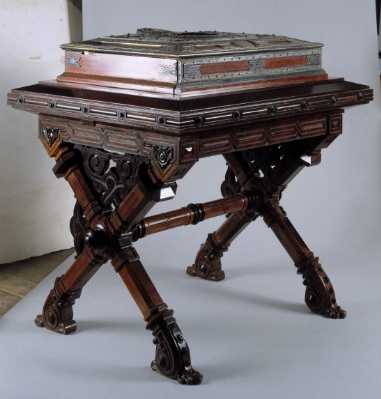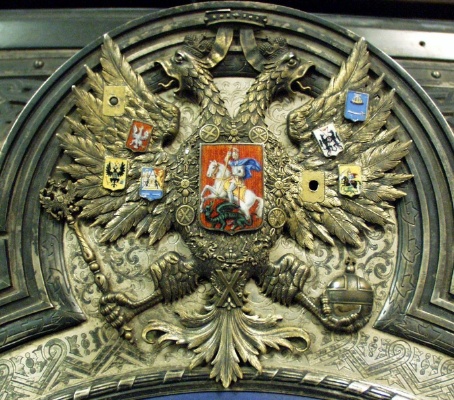Project for the Restoration of a 19th-century Chest-table
 Chest-table. 1879–80. Based on designs by Leonty Benois. Made by Karl Kerem. Amaranth, palisander, silver, enamel. Technique: carving. 105 × 99 × 83.7 cm. Chest: 16 × 75 × 60 cm. Silver content: 8000g
Chest-table. 1879–80. Based on designs by Leonty Benois. Made by Karl Kerem. Amaranth, palisander, silver, enamel. Technique: carving. 105 × 99 × 83.7 cm. Chest: 16 × 75 × 60 cm. Silver content: 8000gThis small chest on a table-like stand was produced by the St Petersburg furniture-maker Karl Kerem on the basis of designs drawn by Leonty Benois. It was presented to Emperor Alexander II by the St Petersburg City Duma to mark the 25th anniversary of his reign. The chest contained watercolour views of St Petersburg that are now in the Hermitage’s stocks of graphic art.
The carved table base was made from palisander (Brazilian rosewood) in a pseudo-Russian style, with trestle legs connected by a crossbar, with decorative wooden nails and an inset chest made from the exotic wood amaranth, also known as purpleheart. The chest is embellished with a silver plaque or mount with enamelling that was made at Pavel Sazikov’s factory. The plaque carried the Russian coat-of-arms and the inscription To Emperor Alexander II from the City of Saint Petersburg with the dates 1855 and 1880. Inside and outside the mount carries the marks: Sazikov; 1880; IE 1880; 84.
 The table-chest. Close-up view
The table-chest. Close-up viewAlexander Benois’s reminiscences about this chest have survived:
“…the sumptuous gift that the City Duma intended to present to the Emperor was made ready in our apartment. That gift consisted of a large chest of precious wood decorated with silver ornamentation and coloured enamel. This chest rested on a special superbly carved table-base (both the chest and the table were made to the designs of my brother, Leonty). The chest contained 25 large sheets of paper on which the most significant events to have taken place in St Petersburg during Alexander II’s reign were depicted in watercolour as well as the most significant buildings constructed in that time.”
This unique item is in need of restoration and has obvious damage: general soiling, cracks and losses. Both the metal and the wooden elements have undergone natural deformation, which has resulted in breaks in the metal construction and failure of the joints respectively. A large number of the fastenings have been lost on the metal, as well as the enamel coats-of-arms, decorative and silver cover pieces and strips. On the wood, there are losses of varnish and of four elements with openwork carving.
 The table-chest. Close-up view
The table-chest. Close-up view